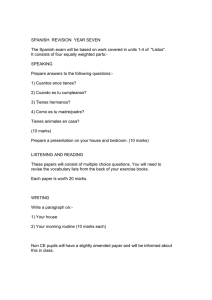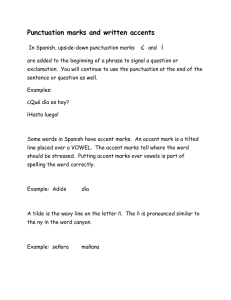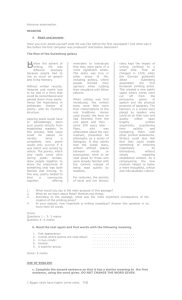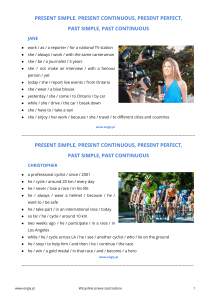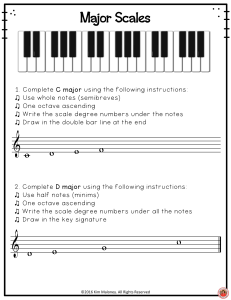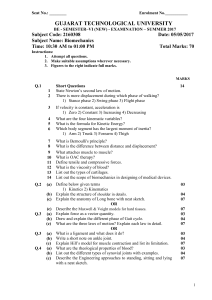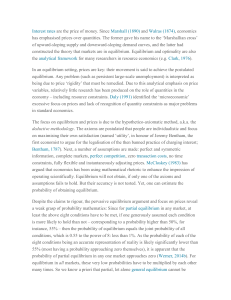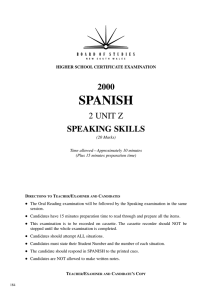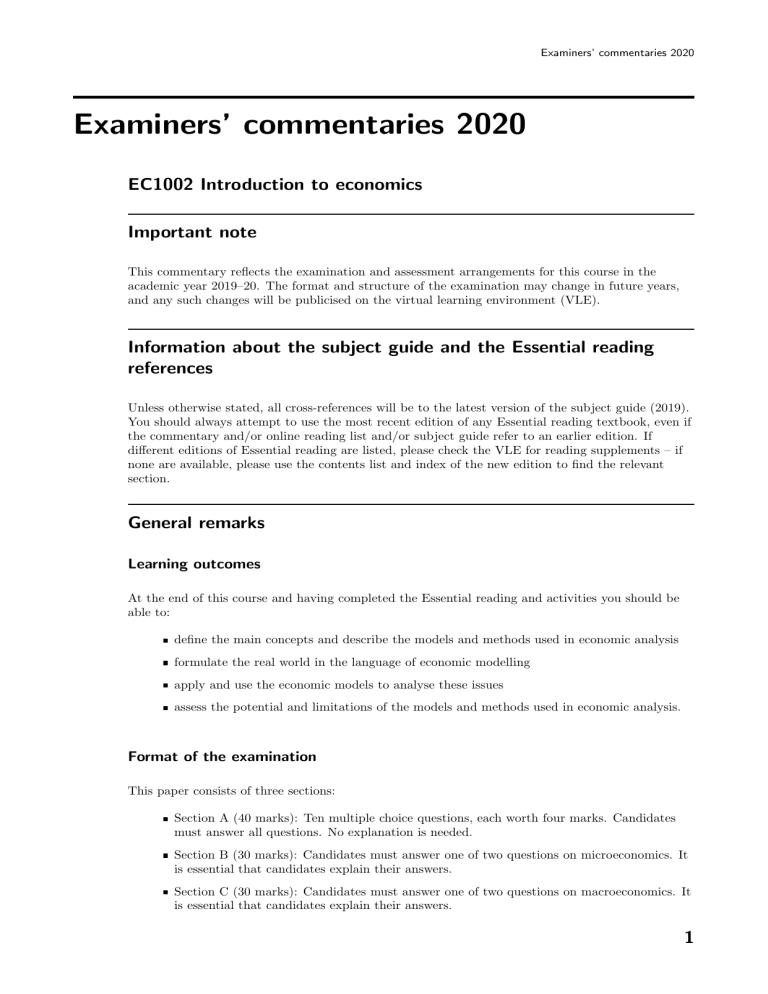
Examiners’ commentaries 2020 Examiners’ commentaries 2020 EC1002 Introduction to economics Important note This commentary reflects the examination and assessment arrangements for this course in the academic year 2019–20. The format and structure of the examination may change in future years, and any such changes will be publicised on the virtual learning environment (VLE). Information about the subject guide and the Essential reading references Unless otherwise stated, all cross-references will be to the latest version of the subject guide (2019). You should always attempt to use the most recent edition of any Essential reading textbook, even if the commentary and/or online reading list and/or subject guide refer to an earlier edition. If different editions of Essential reading are listed, please check the VLE for reading supplements – if none are available, please use the contents list and index of the new edition to find the relevant section. General remarks Learning outcomes At the end of this course and having completed the Essential reading and activities you should be able to: define the main concepts and describe the models and methods used in economic analysis formulate the real world in the language of economic modelling apply and use the economic models to analyse these issues assess the potential and limitations of the models and methods used in economic analysis. Format of the examination This paper consists of three sections: Section A (40 marks): Ten multiple choice questions, each worth four marks. Candidates must answer all questions. No explanation is needed. Section B (30 marks): Candidates must answer one of two questions on microeconomics. It is essential that candidates explain their answers. Section C (30 marks): Candidates must answer one of two questions on macroeconomics. It is essential that candidates explain their answers. 1 EC1002 Introduction to economics Textbook The answers make extensive reference to the textbook for the course, referred to as BVFD. The textbook is: Begg, D., G. Vernasca, D. Fischer, and R. Dornbusch, Economics (2014) McGraw–Hill (11th edition). What the examiners are looking for When answering the long questions (Sections B and C), some candidates had problems because they were not familiar with the material. The examiners look for clear and logical arguments which explain the material and answer the precise question asked – putting in irrelevant material makes for a less clear answer. Some candidates found this difficult, and it was obvious that they had not fully understood the material. Examination strategy Make the most of what you know in the examination room. Read the wording of the questions very carefully and answer the exact question asked. Explain your answer. Answer the right number of questions. Plan your time. Do not spend too much time on any question. If you get stuck on part of a question move on to the next question you answer and come back to the original question if you have time. Start each answer on a new double page. Arrange your answer so that you do not have to turn over a page to see a diagram you are discussing. Practise drawing diagrams when you are studying. Draw your diagrams large enough and carefully enough that the examiner can easily see what you are doing. Examination revision strategy Many candidates are disappointed to find that their examination performance is poorer than they expected. This may be due to a number of reasons, but one particular failing is ‘question spotting’, that is, confining your examination preparation to a few questions and/or topics which have come up in past papers for the course. This can have serious consequences. We recognise that candidates might not cover all topics in the syllabus in the same depth, but you need to be aware that examiners are free to set questions on any aspect of the syllabus. This means that you need to study enough of the syllabus to enable you to answer the required number of examination questions. The syllabus can be found in the Course information sheet available on the VLE. You should read the syllabus carefully and ensure that you cover sufficient material in preparation for the examination. Examiners will vary the topics and questions from year to year and may well set questions that have not appeared in past papers. Examination papers may legitimately include questions on any topic in the syllabus. So, although past papers can be helpful during your revision, you cannot assume that topics or specific questions that have come up in past examinations will occur again. If you rely on a question-spotting strategy, it is likely you will find yourself in difficulties when you sit the examination. We strongly advise you not to adopt this strategy. 2 Examiners’ commentaries 2020 Examiners’ commentaries 2020 EC1002 Introduction to economics Important note This commentary reflects the examination and assessment arrangements for this course in the academic year 2019–20. The format and structure of the examination may change in future years, and any such changes will be publicised on the virtual learning environment (VLE). Information about the subject guide and the Essential reading references Unless otherwise stated, all cross-references will be to the latest version of the subject guide (2019). You should always attempt to use the most recent edition of any Essential reading textbook, even if the commentary and/or online reading list and/or subject guide refer to an earlier edition. If different editions of Essential reading are listed, please check the VLE for reading supplements – if none are available, please use the contents list and index of the new edition to find the relevant section. Comments on specific questions This paper consists of THREE sections: Section A (40 marks): TEN multiple choice questions, each worth FOUR marks. Candidates must answer ALL questions. No explanation is needed. Section B (30 marks): Candidates must answer ONE of TWO questions on microeconomics. It is essential that candidates explain their answers. Section C (30 marks): Candidates must answer ONE of TWO questions on macroeconomics. It is essential that candidates explain their answers. Section A: Multiple choice questions Candidates should answer ALL questions from this section. Choose one answer for each question: no explanation is needed. Note that some questions ask you to choose which statement IS correct and other questions ask you to choose which statement IS NOT correct. Question 1 If Pete’s indifference curves are upward-sloping and cross one another, his preferences exhibit: (a) Incompleteness and satiation. (b) Non-satiation and decreasing marginal rate of substitution. 3 EC1002 Introduction to economics (c) Incompleteness and increasing marginal rate of substitution. (d) Satiation and a failure of transitivity. Reading for this question See BVFD Chapter 5. Approaching the question (d) is correct. We know that Pete’s indifference curves are upward-sloping and they cross. If preferences satisfied non-satiation the indifference curves would be downward-sloping. Satiation for the goods leads to upward-sloping curves (more is not better here). Now we are left with two possible options and need to think about incompleteness and failures of transitivity. Incompleteness would mean that Pete does not know how to rank different bundles. We cannot rule this out, but we do not have enough information to comment on completeness of preferences. However, we know that failures of transitivity lead to indifference curves crossing, so option (d) is correct. Question 2 If a 10 percent increase in income causes the number of theatre tickets to go up by 5 percent, what is the income elasticity of demand for theatre tickets? (a) 0.5 (b) 2 (c) −0.5 (d) −2. Reading for this question See BVFD Section 4.6 and Case 4.3. Approaching the question (a) is correct. The income elasticity of demand tells us the change in quantity due to a change in income. Here we have the changes and can compute the corresponding elasticity as: 0.05 5% ∆Q = = = 0.5. ∆m 0.1 10% Question 3 A profit-maximising monopolist sets an output of 100 per day and a price of £10. Which of the following statements is true? (a) The firm’s marginal cost and marginal revenue curves intersect at an output of 100, and the point on its demand curve at this output is at £10. (b) The firm’s marginal cost and marginal revenue curves intersect at an output of 100, and the point on its marginal revenue curve at this output is at £10. (c) The firm’s marginal cost and average revenue curves intersect at an output of 100, and the point on its marginal revenue curve at this output is at £10. 4 Examiners’ commentaries 2020 (d) The firm’s marginal cost and average revenue curves intersect at an output of 100, and the point on its average revenue curve at this output is at £10. Reading for this question See BVFD Section 8.6. Approaching the question (a) is correct. Regardless of the numbers we know that at a profit-maximising output the marginal revenue curve and marginal cost curves intersect at the optimal quantity and the point on the demand curve corresponding to that quantity gives the optimal price. Figure 1: The profit-maximising output and quantity for a monopolist can be found by producing the quantity given by setting the marginal revenue curve equal to the demand curve. The corresponding monopoly price can be found by looking at the price that consumers are willing to pay for that quantity. Question 4 In a tennis game Serena is playing against her opponent Maria. Serena can choose to play more in the front or in the back. Maria can also choose to play more in the front or in the back. If they both make the same choice, Serena wins. If they make different choices, Maria wins. This tennis game has: (a) two Nash equilibria in pure strategies. (b) no Nash equilibrium in pure strategies. (c) only one Nash equilibrium in which Serena always wins. (d) only one Nash equilibrium in which Maria always wins. Reading for this question See BVFD Section 9.4. 5 EC1002 Introduction to economics Approaching the question (b) is correct. There is no equilibrium in pure strategies. Rigorous analysis is not needed here, we can think about the intuition. Serena will want to match Maria’s move and Maria will want to optimally choose the opposite move. For instance, if Serena plays more in the front Maria will want to play more in the back. However, if this is the case Serena will want to move to the back and, if so, Maria will want to play more in the front. Question 5 Assume that the demand for a new software is P (Q) = 120 − 2Q. The cost of producing it is C(Q) = 4Q for a monopolist. What is the deadweight loss associated with the monopoly in this market? (a) 1,682 (b) 1,566 (c) 841 (d) 775. Reading for this question See BVFD Section 8.7. Approaching the question (c) is correct. To understand why we first need to find the profit-maximising price and quantities for the monopolist and compare them with the perfectly competitive outcome. For a monopolist profits are: Π = revenues − costs = P (Q)Q − C(Q) = (120 − 2Q)Q − 4Q. Here we can either set MR = MC or take the first derivative to find: 120 − 4Q − 4 = 0 or Qm = 29. The corresponding price is: P (Qm ) = 120 − 2Qm = 120 − 2 × 29 = 62. Now we need the perfectly competitive outcome. Here price would be P = MC = 4 and the quantity would be 4 = 120 − 2Q, which gives us Q = 58. The deadweight loss is then: 1 × (58 − 29)(62 − 4) = 841. 2 Question 6 The table below reports employment data (approximated to the nearest number, in millions of people) for Malaysia in April 2019. Given this data, what was the participation rate in Malaysia in April 2019 (rounded to the first decimal point)? 6 Examiners’ commentaries 2020 Malaysia: Employment data for April 2019 (in millions) Employed 15.01 Unemployed 0.52 Outside Labour Force 7.18 Population 32.6 (a) 69.7% (b) 96.7% (c) 68.4% (d) 46%. Reading for this question See BVFD Section 10.4. Approaching the question (c) is correct. We have: participation rate = labour force . working age population Also: labour force = employed + unemployed = 15.53 and: working age population = labour force + outside labour force = 15.01 + 0.52 + 7.18 = 22.71 making the participation rate equal to 15.53/22.71 = 68.4%. Question 7 Which of the following statements about the balance of payments IS correct? (a) The current account measures the difference between payments for goods manufactured in a given nation and exported, and payment for goods manufactured outside the given nation and imported by it. It does not include services. (b) The capital account is the national flow of transfer payments relating to capital items. (c) The financial account includes only international purchases of assets. (d) The capital account is the international flow of transfer payments relating to capital items. It also includes services in its calculation. Reading for this question See BVFD Section 24.3. Approaching the question (d) is correct. The capital account is the international flow of transfer payments relating to capital items. It also includes services in its calculation. 7 EC1002 Introduction to economics Question 8 In the imaginary island of Pacifica production only includes coconuts and pineapples. The table below reports the quantity of coconuts and pineapples sold in Pacifica along with their prices. Based on this data and using 2010 as the base year what was Pacifica’s real GDP in 2015? Year 2010 2015 Quantity of coconuts 305 320 Price per coconut $5 $6 Quantity of pineapples 160 200 Price per pineapple $3 $5 (a) $2,200 (b) $2,920 (c) $2,005 (d) $2,630. Reading for this question See BVFD Section 15.5. Approaching the question (a) is correct. Real GDP is computed using the quantities produced in 2015, evaluated at 2010’s prices. Here this means: 320 × $5 + 200 × $3 = $2,200. Question 9 In a country with a working age population equal to 75, aggregate labour demand is ND = 72 − 3W and labour supply is NS = 9 + 6W . Which of these statements IS NOT true? (a) The equilibrium wage in this economy is W = 7. (b) The equilibrium inactivity rate of this economy is zero. (c) The labour supply curve is upward sloping. (d) The equilibrium level of employment is N = 51. Reading for this question See BVFD Chapter 23. Approaching the question (b) is not true. We can find the equilibrium in this market by setting demand equal to supply: ND = 72 − 3W = NS = 9 + 6W ⇒ 72 − 3W = 9 + 6W. This gives us W = 7. Plugging this in the labour supply or labour demand curve gives N = 51. If there are 75 people in the working age population and only 51 are employed in equilibrium this 8 Examiners’ commentaries 2020 tells us that the inactivity rate, i.e. the proportion of people who are in the working age population but not employed, is: 75 − 51 = 32% 6= 0. 75 Question 10 If in January 2015 $100 exchanged for |6,156 (Indian rupees) and in January 2020 $100 exchanged for |7,133, then between 2015 and 2020: (a) the rupee appreciated relative to the dollar. (b) the dollar appreciated relative to the rupee. (c) Indian goods became more expensive to Americans. (d) American goods became more expensive to Americans. Reading for this question See BVFD Section 24.4. Approaching the question (b) is correct. Intuitively, $100 is now worth more in rupees and so the dollar has appreciated with respect to the rupee. Section B: Microeconomics Answer one of the two following long questions. It is essential that you explain your answers. Question 11 A firm manufactures quad bikes (‘quads’). Each quad is made using one frame (x1 ) and four wheels (x2 ). Each frame costs £10 and each wheel costs £3. The output of the firm can hence be represented by the function: 1 min x1 , x2 . 4 (Hint: this is similar to working with min[K, 1/4L], but instead of considering prices r and w you may consider prices p1 and p2 for the inputs.) (a) What is an isoquant? Show the isoquants for producing two quads, three quads and seven quads. (5 marks) (b) Derive the input demands for frames and wheels for the firm. How do they depend on the input prices? What is the maximum amount of quads the firm can produce if the number of wheels is fixed at 12? Assume that the firm is producing the maximum amount of quads. What is the marginal product of adding an extra frame? (10 marks) (c) Define the firm’s cost function and derive it. Assume that each wheel costs £4 and each frame costs £10. What is the cost of producing 7 quads? (5 marks) 9 EC1002 Introduction to economics (d) Assume that the firm needs to pay £50 per day to rent the factory to produce quads (this is a fixed cost). Continue to assume that each wheel costs £4 and each frame costs £10. Suppose that the firm can only produce 10 quads per day and the rent has already been paid for today. If the price at which the firm can sell quads is £30 should the firm produce today? Explain your reasoning. (5 marks) (e) Continue to assume that the daily rent is £50, each wheel costs £4 and each frame costs £10. Suppose that the firm can only produce 10 quads per day and the rent can be stopped (so the cost of producing zero quads is zero). If the price at which the firm can sell quads is £30 should the firm produce today? Explain your reasoning. (5 marks) Reading for this question See BVFD Chapter 7. Approaching the question (a) An isoquant shows all the combinations of inputs that allow the firm to produce a given quantity of the output. Many candidates defined isoquants correctly, but occasionally some definitions referred to the utility of a bundle or the cost needed to produce a quantity to define isoquants. There is no need to define cost functions here or to refer to the utility of a bundle. Isoquants will be L-shaped with kinks at (2, 8), (3, 12) and (7, 28). Many candidates plotted L-shaped curves on the diagram but failed to show the optimal bundles and the line x2 = 4x1 where all the optimal bundles (the kinks) lie. A common mistake was drawing three different graphs. Many isoquants can be represented on the same graph, so there is no need to have three diagrams. Figure 2: A representation of the isoquants corresponding to the production of 2, 3 and 7 quad bikes. All the bundles are chosen so that x1 = x2 /4 or, equivalently, 4x1 = x2 . (b) The demands for frames and wheels do not depend on input prices. The firm will always need to demand x1 = x2 /4 or it would be demanding too many wheels/frames and not using resources optimally. 10 Examiners’ commentaries 2020 This implies that the input factor demands are x1 = Q and x2 = 4Q. This also shows us that a change in the price of either of the inputs does not imply a reduction for the quantity of that input the firm will need to produce quads. Here there is no possibility for substitution. Because of this, the firm cannot produce more than 3 quads when the number of wheels is fixed at 12. If the firm were to add extra frames after the third one the output would not increase. Many candidates attempted to answer this question by taking a partial derivative. The function is non-differentiable at the kinks, candidates only needed to rely on intuition here. Finally, if we have 12 wheels adding a fourth frame cannot make the output increase, as frames without wheels cannot produce a quad. Hence the marginal product of wheels (i.e. how much increasing the amount of wheels would make output change) when the firm is producing 3 quads is zero. (c) The firm’s cost function is the minimum amount needed to spend on inputs to produce a given amount of output. Excellent answers included an expression for the cost function for any level of production Q. We know from part (b) that the input factor demands are x1 = Q and x2 = 4Q. The corresponding cost function is: C(Q) = p1 x1 + p2 x2 = p1 Q + p2 4Q = Q(p1 + 4p2 ). Most candidates failed to mention this but realised that to produce 7 quads the firm needs 28 wheels and 7 frames so the overall cost function is: 7 × (£10 + £4 × 4) = £182. (d) The marginal cost of producing a quad is £26 (i.e. the cost of one frame and four wheels), so if the firm produces today it will cover all its variable costs and can recover part of the fixed cost. Hence the firm should be producing today. One way to see this is to compare the options the firm has. If the firm does not produce the profits will be Π(0) = −£50, as it still needs to pay rent. Producing the maximum of amount of quads (10) instead yields: Π(20) = −£50 + £(30 − 26) × 10 = −£10. This loss is smaller than if the firm were to shut down and hence the firm should produce today. Stating that the firm is making a loss is not enough here, as in the short run the firm will keep producing whenever P ≥ AVC, which is true in this case, as P = £30 and AVC = £26. Intuitively, while the firm is not making a profit, it is avoiding a bigger loss due to the need to pay for rent costs even if Q = 0. (e) Here there was no need for another calculation as the marginal cost of a quad is the same as in part (d). This time the firm should not produce, as producing the maximum amount of quads (10) yields a profit of Π(10) = −£10 (we know this from part (d)), whereas producing zero costs zero. The firm is better off shutting down. Many candidates argued that the firm should produce in this case as it will be making profits because the firm will not need to pay the rent. This is inaccurate. The firm will not need to pay the rent only if it does not produce any output (Q = 0). However, if Q > 0 the firm will need to incur both the rent cost and variable costs of production. Question 12 For the rest of this question consider a two goods economy where Kim and Jung can trade Ferraris (good x) and VR headsets (good y) with each other. Kim and Jung 11 EC1002 Introduction to economics both enjoy driving Ferraris and having more VR headsets (so more friends can play the same game). They start at the same (high) level of income. Kim has an initial 0 endowment of (x0K , yK ) = (10, 30) and Jung has an initial endowment of 0 0 (xJ , yJ ) = (30, 10). (a) Illustrate the initial endowment in an Edgeworth box. Clearly label the axes and explain the dimensions of the box. Show the indifference curve each of them is on at the endowment point. (6 marks) (b) Consider an allocation where Kim gets (xK , yK ) = (40, 40) and Jung gets the remaining Ferraris and VR headsets. Show where this point is in the Edgeworth box. Is this allocation Pareto efficient? Is it equitable? How likely is this to arise in practice? (8 marks) (c) Assume that Kim has preferences UK (xK , yK ) = 3xK + yK and Jung has preferences UJ (xJ , yJ ) = xJ + 3yJ . Will Kim and Jung trade? Calculate the general equilibrium allocation for Kim and Jung. Compute the utility at the endowment point and at the general equilibrium allocation. Is the new allocation on the contract curve? (10 marks) (d) Assume that a social planner could redistribute initial wealth (the amounts of x and y that Kim and Jung have). Can they reallocate resources so to let Kim and Jung reach the allocation (xK , yK ) = (20, 20) and (xJ , yJ ) = (20, 20) as a general equilibrium (i.e. post-trade) allocation? Can the social planner redistribute resources so make the allocation where Jung owns all the resources in the economy a general equilibrium allocation? (6 marks) Reading for this question See BVFD Chapter 13. Approaching the question (a) The dimensions of the box are given by the total amount of Ferraris and VR headsets, so the Edgeworth box here is a square of size 40 × 40, representing the total amount of good x and the total amount of good y in this economy. The endowment should be close to either the top left corner (if the origin for Kim is the one at the bottom left) or bottom right corner (if the origin for Jung is at the bottom left). We do not yet know Kim’s and Jung’s preferences so we can draw any reasonable indifference curve at the endowment. Candidates should show two indifference curves at the endowment and reflect that utility for Kim and Jung is increasing in different directions. For the person whose origin is at the bottom left, utility increases by going up and right. For the person whose origin is at the top right, utility increases by moving down and left. 12 Examiners’ commentaries 2020 Figure 3: An Edgeworth box for the economy where Kim has an initial endowment of 0 (x0K , yK ) = (10, 30) and Jung has an initial endowment of (x0J , yJ0 ) = (30, 10). (b) The allocation proposed is one where Kim gets everything and Jung nothing. This allocation is efficient, as there are no resources left on the table, but highly inequitable as Jung is left with nothing. Many candidates claimed that the allocation is efficient because we made Kim better off than he was at the endowment point, but the allocation should not be compared to the endowment. This allocation is Pareto efficient because if we wanted to make Jung better off we would need to take away some resources from Kim, making Kim worse off. We also cannot make Kim better off as he already owns all the resources in this economy. In general, a Pareto efficient allocation is one where we cannot make either agent better off without making the other worse off. While efficient, this allocation is inequitable because resources are not shared and one person owns all the Ferraris and VR headsets in the economy. This is incredibly unlikely to happen in practice given our assumption of non-satiated preferences. Jung would never agree to a trade that makes him worse off with respect to his utility at the endowment. Excellent answers also explained that a social planner would be unlikely to want to generate such a high level of inequality in society by structuring a system of transfers. 13 EC1002 Introduction to economics Figure 4: A representation of the allocation where Kim owns all the resources in the economy and Jung has nothing. (c) Yes, both Kim and Jung will find trade beneficial, as their preferences are symmetric. In equilibrium Kim will have (40, 0) and Jung (0, 40). This is easy to see if we think about their preferences intuitively. For Kim and Jung VR headsets and Ferraris are perfect substitutes. Kim prefers Ferraris to VR headsets (each gives him three times the utility of a headset) and Jung has a preference for VR (each VR headset gives him three times the utility of a Ferrari). Because of this, both would prefer to have only their preferred good and move to the equilibrium where Kim owns all the 40 Ferraris and Jung owns all the 40 VR headsets. This allocation is efficient, as neither could be made better off without taking away resources from the other. This allocation also increases their utility from the initial endowment, where both have a utility of 10 × 3 + 30 = 60. The general equilibrium allocation will be at the bottom right corner of the Edgeworth box and yields a utility of 3 × 40 + 0 = 120. This point is Pareto efficient and so it lies on the contract curve (i.e. the set of all Pareto efficient allocations). (d) To answer this question it is helpful to remember the statements of the First and Second Fundamental Welfare Theorems. The First Fundamental Welfare Theorem tells us that if there exists a general equilibrium, the allocation at the equilibrium will be Pareto efficient. This also implies that an allocation that is not Pareto efficient cannot be a general equilibrium allocation. The Second Fundamental Welfare Theorem states that the social planner can turn any point on the contract curve (i.e. any Pareto efficient allocation) into a general equilibrium allocation given a set of transfers. Now let us consider whether the two proposed allocations are Pareto efficient. The allocation (xK , yK ) = (20, 20) and (xJ , yJ ) = (20, 20) gives Jung and Kim incentives to trade. To see why consider their preferences and the argument made in part (c). Kim prefers Ferraris to VR headsets, while Jung prefers VR headsets to Ferraris. Kim can give Jung 20 VR headsets in exchange for 20 Ferraris, making both himself and Jung better off. Before trade their utility would be U (20, 20) = 20 + 20 × 3 = 80. After the proposed trade we would again be at the general equilibrium allocation where both have a utility of 120. This is one of the many possible Pareto improvements. Any trade that gives more Ferraris to Kim in exchange for more VR headsets to Jung makes both of them better off, i.e. is a Pareto improvement. If a Pareto improvement is possible the proposed allocation was not Pareto efficient and so cannot be obtained as a general equilibrium by the First Fundamental Welfare Theorem. 14 Examiners’ commentaries 2020 Hence a social planner cannot find a redistribution that would make both of them have 20 Ferraris and 20 VR headsets an equilibrium, as both can find a profitable deviation. The allocation where Jung owns all the resources, instead, is Pareto efficient. This is specular to the allocation proposed in part (b), where Kim owned all the resources. In the same fashion as in part (b) we can argue that this is a Pareto efficient allocation. This means that by the Second Fundamental Welfare Theorem this allocation can be reached as a general equilibrium point if the social planner implements the right set of transfers. As Kim would never want to trade to achieve this allocation, the only set of transfers that will make this an equilibrium is one where the social planner gives everything to Jung. Section C: Macroeconomics Answer one of the two following long questions. It is essential that you explain your answers. Question 13 In this question we will reflect on the Australian fires from last year. A wide part of Australia has experienced severe fires in the last year, which made the economy much less productive and had severe impacts on business activities. (a) Explain why you could expect negative shifts in the aggregate demand curve following the fires. What would you expect are the drivers of this shift? Reflect on each of the components of the aggregate demand and comment on whether they are likely to change due to the fires. (6 marks) (b) Explain why you could expect negative shifts in the aggregate supply curve following the fires. What would you expect are the drivers of this shift? Reflect on each of the components of the aggregate supply and comment on whether they are likely to change due to the fires. (6 marks) (c) Show the shifts discussed in parts (a) and (b) graphically. You may assume an upward-sloping AS curve for simplicity. Can you predict what happens to real GDP and the price level? (8 marks) (d) The fires in Australia can also be considered a decrease in the country’s stock of capital. You may use the Solow model to show what happens when capital decreases and what the model predicts for the new growth rate. Are these consequences likely to happen in practice? (10 marks) Reading for this question See BVFD Chapter 16 (Aggregate Demand), Chapter 21 (Aggregate Supply) and Section 28.5 (Growth and the Solow Model). Approaching the question (a) Aggregate Demand (AD) is an economic measurement of the total amount of demand for all finished goods and services produced in an economy. Aggregate demand is expressed as the total amount of money exchanged for those goods and services at a specific price level and point in time. Aggregate demand is Y = A − b(r − π), with A > 0 and b > 0. This does not get us very far here so it helps to think about an open economy and consider the aggregate demand Y = C + I + G + N X, where C stands for consumption, I for investment, G for government expenditure (the 15 EC1002 Introduction to economics difference between tax revenues and government spending) and N X stands for net exports (the difference between exports and imports). Aggregate demand consists of all consumer goods, capital goods (factories and equipment), exports, imports, and government spending. Many candidates pointed out that consumption, investment and net exports are likely to fall as a consequence of the fires. A possible way to explain why this could happen is below. After a natural disaster, income drops making consumption, investment and capital all decrease. The first two are lower because of the lower income, whereas capital is lower because the fires have destroyed natural capital. Government spending could stay the same or increase if the government increases spending to attenuate the impact of the fires. This was not the only possible explanation for the downward shift in the AD curve and a good discussion of the reasons why the curve might shift down would have been awarded full marks. (b) Aggregate supply is the total supply of goods and services produced within an economy at a given overall price in a given period. It is represented by the aggregate supply curve, which describes the relationship between price levels and the quantity of output that firms are willing to provide. A shift in the aggregate supply can be attributed to many variables, including changes in labour, technological innovations, an increase in wages, an increase in production costs, changes in producer taxes, subsidies and changes in inflation. Here the most likely factor to affect the aggregate supply are the costs of production, now higher because of the factories which got burnt, and the labour force may be reduced, but as above any good explanation would have been awarded full marks. (c) The fires were an unexpected natural disaster. They create a negative effect on the aggregate supply and aggregate demand, causing a shift in both. These shifts imply lower GDP (either of the two shifts would be enough to determine this, and here they reinforce each other), but because both curves shift left the effect on the price level is not straightforward. Excellent answers included three graphs to reflect why the price level could increase, stay constant, or decrease depending on the magnitudes of the shifts of aggregate demand and aggregate supply. Figure 5: AD and AS shift down, total output decreases to Y 0 , price level increases. 16 Examiners’ commentaries 2020 Figure 6: AD and AS shift down, total output decreases to Y 0 , price level remains constant. Figure 7: AD and AS shift down, total output decreases to Y 0 , price level decreases. (d) It is helpful to think of this situation as a deviation from the steady state. Along the steady-state path, output, capital and labour grow at the same rate. Hence output per worker and capital per worker are constant. In the steady state, capital per person is constant. Hence investment per person sy must equal depreciation, the investment per person needed to keep k constant by making capital grow as fast as the old one becomes obsolete. k ∗ is the steady-state capital per person and y ∗ the steady-state output per person. Capital, output and labour all grow at the same rate n along this steady-state path. Now the fires destroy some of the capital. If capital per worker is lower, the economy is left of the steady state. Per capita savings and investment are higher than the depreciation. A loss in capital in the Solow model implies that growth will be faster (because it starts again at a lower level of capital per worker where the marginal product of capital is higher). Excellent answers pointed out that this theory relies on many assumptions, for example constant returns to scale, that may not be satisfied in reality. Moreover, adjustments are likely to take time and Australia may not be able to recover from the fires as quickly as the model suggests. The graph can either show a movement along the curves, to reflect the lower level of capital or a shift, assuming that some technology was destroyed in the fires. While it is certain that 17 EC1002 Introduction to economics capital will be lower, the production function and technology need not have changed. As technology is likely to be shared knowledge this possibility is more likely and so below a diagram showing only a change is capital is reported. Figure 8: A loss in capital from k ∗ to k 0 brings about faster growth up until the country reaches again the previous steady state. Output initially drops and then increases again. Question 14 (a) Allen would like to open a business to produce a software that he thinks would be well-received by the market. However, the investment needed to start a business is very high and Allen could barely cover it on his own. The software is very likely to be successful and generate profits, but it takes 2 years before profits are generated. Explain why the existence of a financial intermediary, like a bank, makes Allen’s investment more likely. (4 marks) (b) Banks are financial intermediaries engaged in maturity transformation. Explain what it means for banks to engage in maturity transformation and what are the risks associated with it for banks and depositors. How do banks make profits? (8 marks) (c) Now assume that Allen needs to borrow £300 to produce his software, which will generate £500 in two years. There are N savers in the economy, each endowed with £2 and each facing a 25% chance that there will be an emergency and they will need their £2 back. What is the minimum value of N such that a financial intermediary can solve the problem of getting money from savers to borrowers? (6 marks) (d) After the 2009 financial crisis, countries in the Basel Committee on Banking Supervision have agreed to raise the mandatory reserves for banks. Explain what happens to the money multiplier and the bank deposit multiplier if the reserve ratio is increased and what governments need to do if they wish to maintain the previous level of broad money M. (8 marks) 18 Examiners’ commentaries 2020 (e) What is the difference between a liquidity crisis and a solvency crisis? When Lehman Brothers went under, its debts (liabilities) were much greater than its assets. Did Lehman Brothers experience a solvency or a liquidity issue? (4 marks) Reading for this question See BVFD Chapters 18 and 19. Approaching the question (a) Allen would need a large investment to be able to start his business and he is unlikely to undertake it with his own money as we know from the question that he could barely afford it. We also know that the business is very likely to be successful, but not sure to be, so Allen would be risking most of his money if he were to invest without a loan. A financial intermediary can lend the money to him (asking for interests) and alleviate this risk. Through financial intermediaries, savers can help Allen start his activity, by investing only a small part of their capital in Allen’s firm, and hence experiencing a lower risk than Allen would on his own. In turn, this investment allows Allen to move forward with his activity and generate profits in the future. (b) Banks transform short term liabilities, like deposits, into long-term investments. Deposits are zero-maturity investments, as the holders can decide to withdraw the money at any point in time. Businesses, on the other hand, have longer maturity as it takes time before they can become profitable. Banks who engage in maturity transformation, however, run the risk of having a mismatch between the short-term maturities of their deposits and the long-term maturities of their loans. If all their depositors were to simultaneously ask for their money back banks would not know how to satisfy their demands. Banks make most of their profits by asking for interest on loans higher than those they pay on deposits. (c) Each person can save £2, but has a 25% chance of needing to withdraw the money deposited for an emergency. Here we look for the number N of people who are needed by the bank to be able to cover the cost of the investment (£300) and account for the possibility of withdrawal by 25% of the people. To do so we can make sure that the deposits are high enough to cover the possible expenses (the loan and the emergency withdrawals). This is equivalent to solving: 2N = 300 + 0.25 × 2N so we need N = 200 investors. To check why, notice that with 200 investors the bank receives £400, £300 goes to the investment and £100 as reserves in case the 25% of people decided to withdraw all their money (so in case 50 people withdrew £2). (d) The money multiplier is the ratio of broad money to the monetary base. The monetary base, or narrow money, is the quantity of notes and coins in private circulation plus the quantity of reserves held by commercial banks. Broad money includes all assets fulfilling the functions of money, and is mostly composed of bank deposits. The bank deposit multiplier is the ratio of broad money to bank reserves. When the reserve ratio is increased the values of both the money multiplier and bank deposit multiplier will decrease. If the government wishes to maintain the previous level of broad money M, it will need to inject considerably more narrow money than previously. To do so it can conduct open market operations and lower the interest rate. 19 EC1002 Introduction to economics (e) A liquidity issue (crisis) occurs when a firm (or country) has a temporary cash-flow problem. Its assets are greater than its debts, but some assets are illiquid (for example, it takes a long time to sell a house – a bank cannot suddenly demand a mortgage loan back). Therefore, although in theory assets are greater than debts, it cannot meet its current payment requirements. A solvency crisis occurs when a country has debts that it cannot meet through its assets, i.e. even if it could sell all its assets, it would still be unable to repay its debts. When Lehman Brothers went under, its debts (liabilities) were much greater than its assets. Therefore, even though it had access to temporary funds from the Federal Reserve, this access to liquidity could not solve the underlying problem that it could not meet its liabilities. This is an example of a solvency crisis. 20
